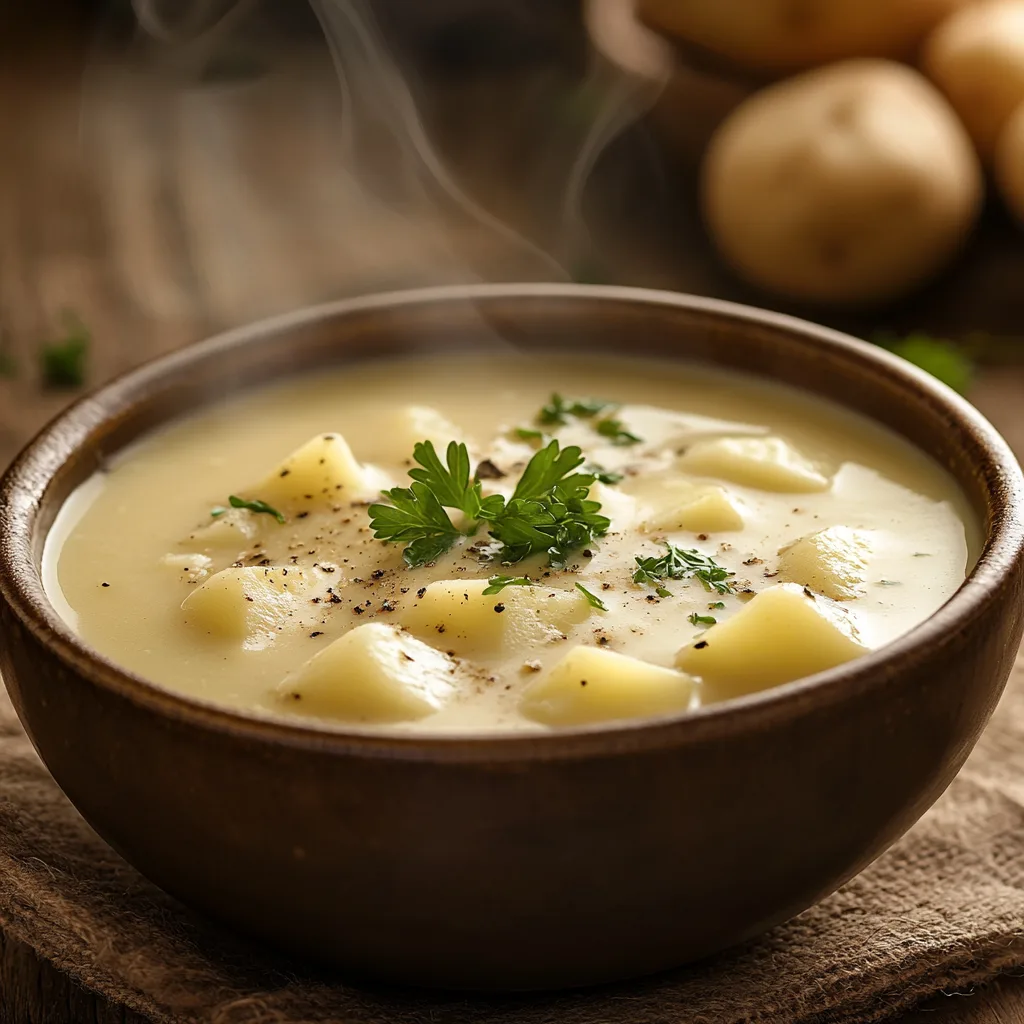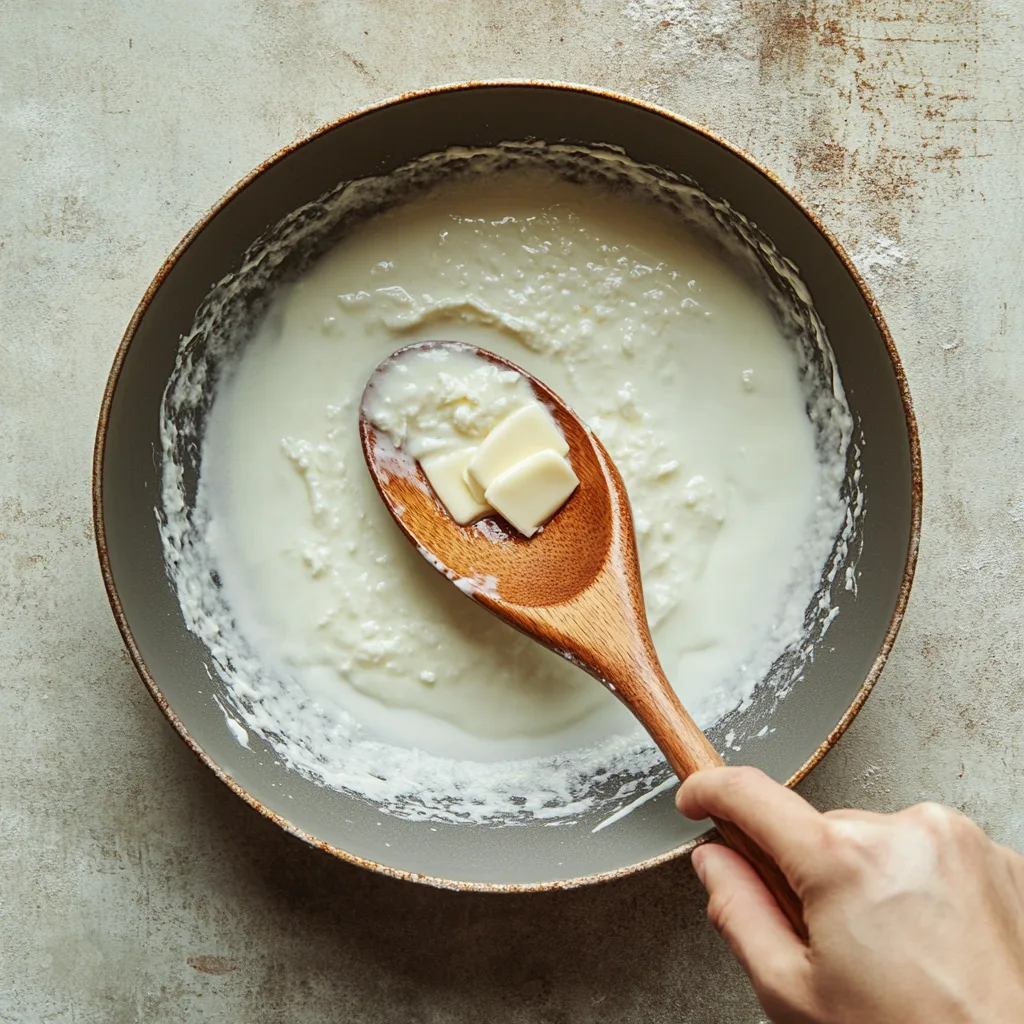Introduction
Potato soup is a comforting dish that warms the soul, but sometimes it turns out thinner than we’d like. Whether you’re aiming for a creamy texture or a thicker, heartier bowl, knowing the right techniques and ingredients can make all the difference. In this article, we’ll travel over various ways to thicken potato soup, from natural thickeners to gluten-free options, while answering the big question: What is the best thickener for potato soup? You’ll discover methods that suit different dietary preferences and increase both texture and flavor.
Let’s dive into the first part, where we discuss why thickening is sometimes necessary and provide an overview of the common solutions available.
Introduction to Potato Soup Thickening (200 Words)
Why Potato Soup May Need a Thickener
Potato soup, while naturally rich due to the starch content in potatoes, can occasionally turn out thinner than expected. This might happen if you’ve added too much liquid or if the potatoes used have a lower starch content. Certain recipes, like those relying on broth or light milk, can also yield a thinner consistency. A thin potato soup may taste great, but it can feel less satisfying, especially when you’re looking for that signature creamy texture.
Thickening potato soup isn’t just about consistency—it also increase its mouthfeel, making every spoonful indulgent and hearty. Moreover, the right thickness allows the soup to hold onto toppings like croutons, cheese, or bacon without them sinking straight to the bottom.
Overview of the Best Thickeners for Potato Soup
When it comes to thickening potato soup, there’s no one-size-fits-all answer. Common options include natural thickeners, like mashing potatoes or blending part of the soup, as well as add-ins like flour, cornstarch, or cream. Each thickening method has its own advantages and nuances. For example, using mashed potatoes keeps the dish naturally starchy, while cream or cheese adds richness. Gluten-free solutions, like arrowroot or tapioca starch, are fantastic for dietary restrictions.
Natural Potato Soup Thickeners
How Potatoes Act as the Best Natural Thickener for Potato Soup
Potatoes themselves are the star of any potato soup, and their high starch content makes them a natural thickening agent. To achieve a thicker consistency, you can mash or blend a portion of the cooked potatoes directly into the soup. Russet potatoes, with their high starch and low moisture content, are particularly effective for this purpose. Simply remove a few cooked chunks, mash them thoroughly, and stir them back into the pot.
Another approach is to dice raw potatoes finely and allow them to break down while cooking. This gradual release of starch not only thickens the soup but also increase its rich, creamy texture. By blending a portion of the soup, you create a smooth base while retaining some chunky bites for texture. For more details on how potato types affect soup,
Cornstarch vs. Flour: Which is the Best Potato Soup Thickener?
When it comes to external thickening agents, cornstarch and flour are the most common options. Cornstarch is twice as powerful as flour, meaning you’ll need less to achieve the same results. To use either, create a slurry by mixing equal parts of the powder with cold water or broth, then gradually stir it into your simmering soup. This increase a lump-free consistency.
Flour adds a subtle flavor, whereas cornstarch is flavor-neutral, making it suitable for maintaining the soup’s potato essence. Keep in mind, though, that overuse of either can make the soup overly thick or sticky, so moderation is key.
What is the best thickener for potato soup? Ultimately, the natural starch in potatoes combined with small additions of cornstarch or flour often strikes the perfect balance.
Dairy-Based Thickeners
Cream Cheese: A Rich and Tangy Option
Cream cheese is a fantastic way to thicken potato soup while adding a velvety texture and a tangy kick. Its consistency blends perfect into the soup, creating a luxurious mouthfeel. To use cream cheese, add softened portions to your soup near the end of cooking and whisk until it dissolves. Not only does this method thicken the soup, but it also increase its flavor profile, giving it a mild tanginess that complements the potatoes.
For those who prefer non-dairy options, cashew cream can be a substitute with similar thickening properties and a slightly nutty flavor.
Heavy Cream or Half-and-Half: Adding Creaminess Without Overwhelming the Flavor
Heavy cream and half-and-half are traditional choices for achieving a thick and creamy soup. Unlike cornstarch or flour, these options thicken through fat content rather than starch. Simply stir in a splash of either toward the end of cooking to enrich the soup’s consistency.
Heavy cream delivers a richer flavor, while half-and-half is a lighter option that still provides noticeable creaminess. Both work beautifully in recipes that don’t rely on strong thickeners but rather balance the natural starch of potatoes. However, to avoid curdling, always add dairy at low heat.
By incorporating these dairy options, you not only thicken the soup but also raise its indulgence factor. Still wondering What is the best thickener for potato soup? The right choice depends on your preference for tanginess or richness.
Alternative Ingredients for Thicker Soup
Bread Crumbs and Croutons: An Unconventional Approach
Bread crumbs and croutons might not be the first things that come to mind when thinking about what is the best thickener for potato soup, but they’re surprisingly effective. By adding stale bread or toasted croutons into the soup, you create a natural thickening effect as the bread absorbs the liquid and breaks down. This method not only boosts the soup’s texture but also reduces food waste by using leftover bread.
To use this method, toss a handful of bread crumbs or croutons into the pot during the final stages of cooking. Stir occasionally to help them dissolve into the soup. This approach works best for thicker, rustic-style soups where a slight texture variation is welcome.
Beurre Manié: The Butter-Flour Paste Technique
The French beurre manié, or kneaded butter, is another excellent option for thickening potato soup. This paste, made by combining equal parts softened butter and flour, is added to hot soup and stirred until it melts and blends perfect . The butter not only enriches the flavor but also prevents the flour from forming clumps.
Beurre manié is ideal for those seeking a glossy, smooth soup without altering its flavor profile. This technique is especially useful if you want to adjust the consistency at the last minute without creating a separate roux.
For more tips on creative thickening methods, check out this potato soup recipe for inspiration.
Part 5: Gluten-Free Thickening Options
Arrowroot and Tapioca Starch: Gluten-Free Alternatives
For those who need a gluten-free solution, arrowroot and tapioca starch are fantastic choices. Both are derived from plants and work similarly to cornstarch, thickening the soup without altering its flavor. Arrowroot, in particular, is known for producing a clear, glossy finish, making it an excellent option for lighter soups.
To use arrowroot or tapioca starch, mix a teaspoon of the powder with cold water to create a slurry, then stir it into the hot soup gradually. This perfect smooth, lump-free results. Be mindful not to overcook the soup after adding these thickeners, as prolonged heat can break down their thickening properties.
Pureed Vegetables: Adding Nutrients While Thickening
If you’re looking for a more wholesome approach, pureed vegetables can double as a nutrient boost and a thickening agent. Carrots, cauliflower, or even a portion of the cooked potatoes can be blended and added back into the soup. This method increase the soup’s flavor while maintaining its natural, rustic appeal.
Both of these gluten-free methods answer the question What is the best thickener for potato soup? in a way that caters to dietary restrictions without compromising on taste or texture.
For more creative soup ideas, check out other recipes on RecipesSmart.
Thickening Techniques and Tips
Creating a Roux: How to Do It Properly
One of the most classic methods for thickening soups, including potato soup, is using a roux. A roux is a cooked mixture of fat (typically butter) and flour that serves as a base for soups, sauces, and stews. To make a roux, melt butter in a pan over medium heat, then whisk in an equal amount of flour until the mixture is smooth and golden. Cook for a minute or two to remove the raw flour taste.
Once the roux is ready, slowly add it to the simmering soup, stirring constantly to prevent lumps. This technique not only thickens the soup but also imparts a rich, buttery flavor. For potato soup, a light roux works best, as it allows the potato’s flavor to shine through. Many home cooks swear by this method when answering the question, What is the best thickener for potato soup?
Making a Slurry: Tips for Avoiding Clumps
A slurry, made by mixing equal parts cornstarch or flour with cold water, is another effective thickening method. The key to a smooth, lump-free slurry is using cold liquid and whisking thoroughly before adding it to the hot soup. Once added, stir continuously until the soup thickens.
Slurries are particularly useful for last-minute adjustments. Unlike a roux, a slurry doesn’t need to be cooked beforehand, making it a quicker option. However, overusing a slurry can lead to an overly thick or pasty soup, so it’s best to add it in small amounts.
Common Mistakes and How to Avoid Them
Over-Thickening: What Happens and How to Fix It
Adding too much thickener is a common mistake when trying to perfect potato soup. Over-thickening can result in a gummy or stodgy texture that overwhelms the natural creaminess of the potatoes. If this happens, don’t panic—simply thin the soup with additional broth, milk, or water, stirring well to regain the desired consistency.
To avoid this issue altogether, add thickeners gradually and test the texture as you go. It’s easier to add more than to fix an overly thick soup.
Adding Ingredients Too Quickly: Achieving a Smooth Texture
Another common pitfall is adding thickening ingredients, like a slurry or roux, too quickly. Doing so can lead to clumps or uneven distribution. To prevent this, always add thickeners slowly while whisking or stirring continuously. This increase that the thickener blends perfect into the soup.
Finally, always keep the soup at a simmer, not a boil, when adding thickeners. High heat can cause dairy-based thickeners to curdle or starch-based ones to lose their thickening power. These simple tips can make a big difference in achieving the perfect consistency.
FAQs About Potato Soup Thickening
What Is the Best Thickener for Potato Soup?
When it comes to potato soup, the best thickener depends on your preferences and dietary needs. For a natural option, using mashed or blended potatoes is both effective and easy. If you’re looking for a richer texture, cream cheese or a light roux can work wonders. Meanwhile, gluten-free alternatives like arrowroot or tapioca starch offer excellent results for those with dietary restrictions.
Each method has its own benefits, so the answer to What is the best thickener for potato soup? largely depends on your desired flavor and texture. Experimenting with different thickeners can help you discover the one that suits your tastes best.
How Can I Thicken Potato Soup Without Changing Its Flavor?
If you’re aiming to thicken potato soup without altering its flavor, natural options like blending cooked potatoes or adding a potato-based thickener are your best bets. These methods preserve the soup’s essence while enhancing its consistency. Cornstarch is another neutral option that thickens effectively without affecting the flavor.
Can I Use Non-Dairy Options to Thicken Potato Soup?
Absolutely! Non-dairy options like coconut milk, cashew cream, or pureed vegetables can thicken potato soup while keeping it dairy-free. These ingredients add creaminess without the use of traditional dairy, making them suitable for vegan or lactose-intolerant individuals.
Conclusion
In summary, thickening potato soup is all about finding the right balance of flavor and texture. Whether you choose natural methods like mashed potatoes, classic techniques like a roux, or alternative options like arrowroot, the key is to experiment and adjust based on your preferences. Each method answers the question What is the best thickener for potato soup? in a unique way, offering different textures and flavors to suit every palate.
Remember, the perfect soup isn’t just about the thickness—it’s about creating a dish that’s comforting, satisfying, and tailored to your taste. By following the tips and techniques shared in this guide, you’ll be well on your way to crafting the ultimate potato soup. For more inspiration, check out other comforting soup recipes online and try new combinations to find your favorite.


